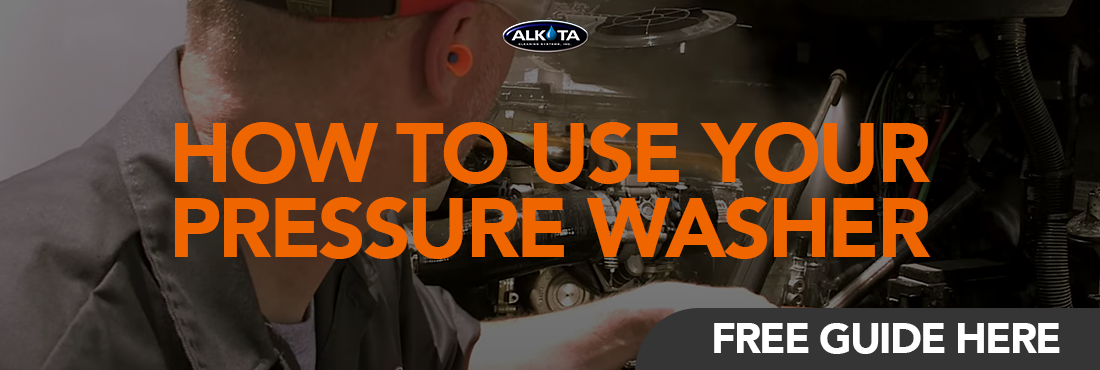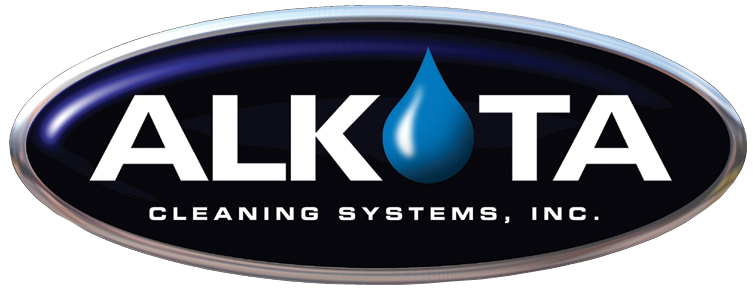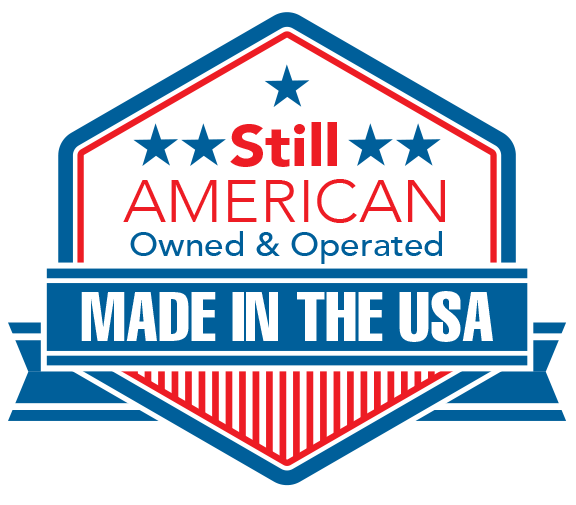The pump is a crucial part of every hot water pressure washer. The goal of this piece is to walk you though different types of pumps, basic maintenance and troubleshooting. Of course if you need more help, please reach out to your local Alkota Dealer.
Pump Types
Triplex Pumps
 Triplex plunger pumps are simply, a pump with a set of three plungers. Plunger pumps consist of a cylinder with a reciprocating plunger in them. The suction and discharge valves are mounted in the head of the cylinder.
Triplex plunger pumps are simply, a pump with a set of three plungers. Plunger pumps consist of a cylinder with a reciprocating plunger in them. The suction and discharge valves are mounted in the head of the cylinder.
The pump does NOT create pressure. The pump simply provides water flow. Pressure is created where we attempt to compress the water: The nozzle (or spray tip).
Diaphragm Pump

When the volume of a chamber of either type of pump is increased (the diaphragm moving up), the pressure decreases, and fluid is drawn into the chamber. When the chamber pressure later increases from decreased volume (the diaphragm moving down), the fluid previously drawn in is forced out. At either end of the fluid chamber in a diaphragm pump. One way valves insure the fluid will flow in the desired direction. Finally, the diaphragm moving up once again draws fluid into the chamber, completing the cycle. This action is similar to that of the cylinder in an internal combustion engine.
Centrifugal Pump
 A centrifugal pump is a rotodynamic pump that uses a rotating impeller to create flow by the addition of energy to a fluid. Centrifugal pumps are commonly used to move liquids through piping. The fluid enters the pump impeller along, or near to the rotating axis, and is accelerated by the impeller, flowing radially outward into the casing (volute chamber), from where it exits into the downstream piping.
A centrifugal pump is a rotodynamic pump that uses a rotating impeller to create flow by the addition of energy to a fluid. Centrifugal pumps are commonly used to move liquids through piping. The fluid enters the pump impeller along, or near to the rotating axis, and is accelerated by the impeller, flowing radially outward into the casing (volute chamber), from where it exits into the downstream piping.
Damaging Pressure
So what causes the most damage and wear to a pressure washer?
Water.
Water can be compressed very little, even at high pressures. This, in essence, is why water is so hard on high pressure systems. The pressure that is needed causes strain on the the fittings, hoses, pipes and you guessed it, pumps.
Tools
If you’re looking to work on your pump, you only need a few common tools, but some specialized tools may also come in handy.
- R
 ubber Mallet
ubber Mallet - Allen Wrenches
- Torque Wrench
- Socket Wrench
Other Tools for Servicing
- Vacuum Gauge
- Pressure Gauge
- Packing Insertions Tools
- Packing Removal Tool
- Pump Force Feeding Attachment
Pump Operation Basics
To be able to work on your pump or troubleshoot, it is important you have a good understanding on how they work.  The pump is the heart of the high pressure cleaning system. The pump applies force to create water flow. Plungers or pistons moving in the pump’s cylinders, applying this force to the water. Pumps are referred to as creating pressure, but that’s not technically correct. A pump actually just creates a flow of water. As the water flows in the inlet, the inlet check valve allows water to flow into the pump, but not back out. The plunger (or piston) then moves forward into the water chamber, forcing the water out the discharge check valve. The discharge check valve allows water to flow out of the pump, and not back in.
The pump is the heart of the high pressure cleaning system. The pump applies force to create water flow. Plungers or pistons moving in the pump’s cylinders, applying this force to the water. Pumps are referred to as creating pressure, but that’s not technically correct. A pump actually just creates a flow of water. As the water flows in the inlet, the inlet check valve allows water to flow into the pump, but not back out. The plunger (or piston) then moves forward into the water chamber, forcing the water out the discharge check valve. The discharge check valve allows water to flow out of the pump, and not back in.
- Most pumps are designed to handle water temperatures of 140°F. When the water in bypass reaches 155° F damage to the pump will begin. Damage can occur to the pump packings, plungers, seals and even to the short bypass hose in external bypass setups. It is a better idea not to leave a pump in bypass mode for more than 2-3 minutes. By simply squeezing the trigger gun you will introduce new cool water into the system.
- Lack of water is the #1 problem with pump performance
- To diagnose any pump problems, it is important to establish flow.
- Always check flow with a graduated container (means to measure the amount of water).
- An air leak will NOT cause cavitation. It usually causes a lack of performance.
Basic Maintenance
CHANGE YOUR PRESSURE WASHER PUMP OIL
- Always follow manufacturer’s specifications for oil.
- Pump crankcase oil must be changed after an initial 50-hour break-in period.
- Oil must be changed every 3 months or at 500 hour intervals thereafter.
We Recommend – General Pump Series 100 Oil / 20-30 Weight, non-detergent
Common Troubleshooting for Hot Water Pressure Washer Pumps
 Milky Oil In Pressure Washer Pump
Milky Oil In Pressure Washer Pump
Milky pump oil is caused by water getting into the crank case. Water can enter the crank case due to:
- Condensation on the inside of the crank case
- Bad oil seals between the crank case and pump head
- Cracked crank case
Pump oil cannot be reconditioned and must be changed to prevent damage to the pump.
Pump Cavitation
Cavitation occurs when the water in the cylinder of the pump boils due to high vacuum caused by insufficient water supply. When the water forms bubbles, and the bubbles explode against the ceramic plunger, it can cause extensive damage to the plunger and damage to head.
Plunger Cracking
 Plunger cracking can result from a variety of situations.
Plunger cracking can result from a variety of situations.
- Thermal Shock
- When the temperature of the incoming water is drastically lower than the temperature of the plunger.
- Over-Tightening
- When the plunger bolt is over tightened, causing stress on the plunger.
Slight Leakage from under manifold
Cause – worn packings or a cracked plunger
Remedy – Install new packing or replace plunger(s)
Oil Leak between crank case and pumping section
Cause – worn crankcase, piston and rod seals or o-rights on plunger retainer worn
Remedy – Replace crank case piston rod seals or replace O-rings
Oil leaking in the area of the crank shaft
 Cause – work crank shaft seal, improperly installed O-ring or bad bearings
Cause – work crank shaft seal, improperly installed O-ring or bad bearings
Remedy – remove oil seal retainer and replace damaged O-ring and/or seals
Excessive play in the area of the crank shaft pulley
Cause – worn main bearing from excessive tension on the belt
Remedy – Replace crankshaft bearing and adjust proper belt tension.
 Water in the crankshaft
Water in the crankshaft
Cause – humid air condensing, worn packings, worn plunger screw O-ring, cracked plunger
Remedy – Change oil more often, use non-detergent oil. Replace packings, O-rings or plunger(s)
Oil leaking underside of crankcase
Cause – Worn crankcase piston rod seals or scored piston rods
Remedy – Replace seals, replace piston rod
Oil Leaking at rear of crankcase

Cause – Damaged crankcase, damaged rear cover O-ring, drain plug O-ring or sight glass O-ring
Remedy – Replace O-ring
Loud Knocking noise in pump
Cause – Loose pulley on crankshaft, damaged bearing or connection rod. Check valve stuck, inadequate water supply
Remedy – check shaft key, tighten bolts or set screw. Replace bearing or connecting rod, inspect check valves, check inlet feed and adjust.
Frequent or premature failure of packings
 Cause – Damaged plunger, over pressure to inlet, abrasive material in fluid, excessive pressure or temperature of fluid, over pressure of pump, running pump dry, upstream chemical injection.
Cause – Damaged plunger, over pressure to inlet, abrasive material in fluid, excessive pressure or temperature of fluid, over pressure of pump, running pump dry, upstream chemical injection.
Remedy – Replace plunger, Reduce inlet pressure on inlet plumbing, install proper filtration, check pressure and fluid temperature, Do not run pump without water, use downstream chemical injection.



